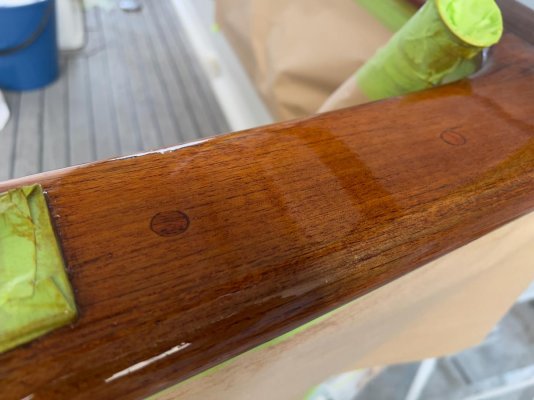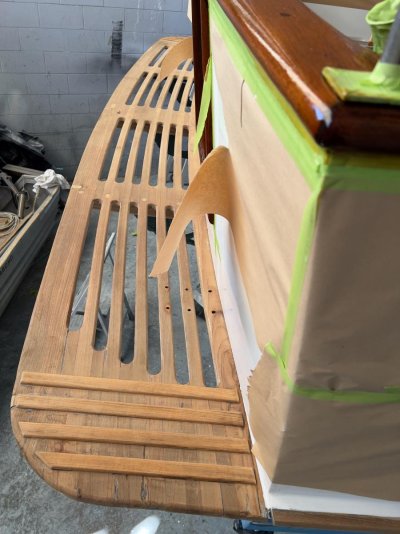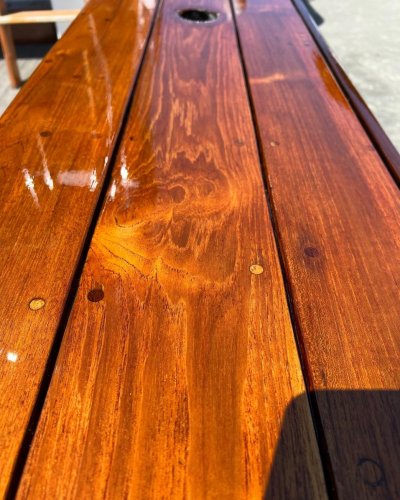Serene
Senior Member
I am nearly at a point where I will go ahead and use the Alwood system for the teak on my boat. It has all been stripped to bare wood and sanded with 80grit so far.
Doing research to ensure I have the best chance of a good outcome, have come up with the following;
Alwood MA Primer Yellow (J9809)
Awlwood Multi-Climate Gloss (J4000)
- Primer applied directly to wood
- Raw wood sanded no finer than 120 grit then cleaned off thoroughly
- One coat of primer is required
- When primer is ‘thumb print’ tacky, start applying clear (touch it and it leaves a print, but does not come off on finger)
- Do not use de-natured alcohol during coating system as it can cause failures (Alwood is moisture cured so alcohol will remove moisture and cause curing problems)
- After applying one (and only one) coat of primer, on the same day lightly sand with 220 grit and then get first coat of clear on
- Use up to 10% of the primer in the build up coats of gloss
- Final coats should be straight clear
- 8 to 10 coats of clear advised over the primer
- If applied the same day, no need to sand between coats (approximately 2hrs @ 25c)
- Alwood can be brushed, rolled or sprayed
- Brushes will tend to swell after a while, but you throw and replace... ideally use solvent resistant foam brushes
- There is a spray reducer and a brushing reducer available
- Any coat that dries overnight needs a light sand with 220 grit or 320 grit
Q. What is the average thumb print / dry time for the primer and also the clear coat?
A. For Awlwood primers it will be touch dry in 8 hours at 25 degrees celsius (77F). For the clear coat it will be touch dry after 2 hours at 25 degrees celsius (77F).
Does anybody see any issues with the above plan?
I have two questions;
1. When is the reducer required?
2. Should the primer bet left to dry and then sanded, or should the first coat of clear be applied right on top of the primer when it is 'thumb print' tacky. What is correct?
Anything else I should be aware of?
Doing research to ensure I have the best chance of a good outcome, have come up with the following;
Alwood MA Primer Yellow (J9809)
Awlwood Multi-Climate Gloss (J4000)
- Primer applied directly to wood
- Raw wood sanded no finer than 120 grit then cleaned off thoroughly
- One coat of primer is required
- When primer is ‘thumb print’ tacky, start applying clear (touch it and it leaves a print, but does not come off on finger)
- Do not use de-natured alcohol during coating system as it can cause failures (Alwood is moisture cured so alcohol will remove moisture and cause curing problems)
- After applying one (and only one) coat of primer, on the same day lightly sand with 220 grit and then get first coat of clear on
- Use up to 10% of the primer in the build up coats of gloss
- Final coats should be straight clear
- 8 to 10 coats of clear advised over the primer
- If applied the same day, no need to sand between coats (approximately 2hrs @ 25c)
- Alwood can be brushed, rolled or sprayed
- Brushes will tend to swell after a while, but you throw and replace... ideally use solvent resistant foam brushes
- There is a spray reducer and a brushing reducer available
- Any coat that dries overnight needs a light sand with 220 grit or 320 grit
Q. What is the average thumb print / dry time for the primer and also the clear coat?
A. For Awlwood primers it will be touch dry in 8 hours at 25 degrees celsius (77F). For the clear coat it will be touch dry after 2 hours at 25 degrees celsius (77F).
Does anybody see any issues with the above plan?
I have two questions;
1. When is the reducer required?
2. Should the primer bet left to dry and then sanded, or should the first coat of clear be applied right on top of the primer when it is 'thumb print' tacky. What is correct?
Anything else I should be aware of?






